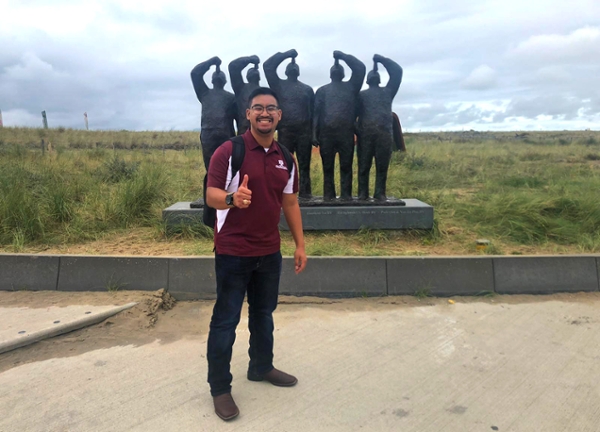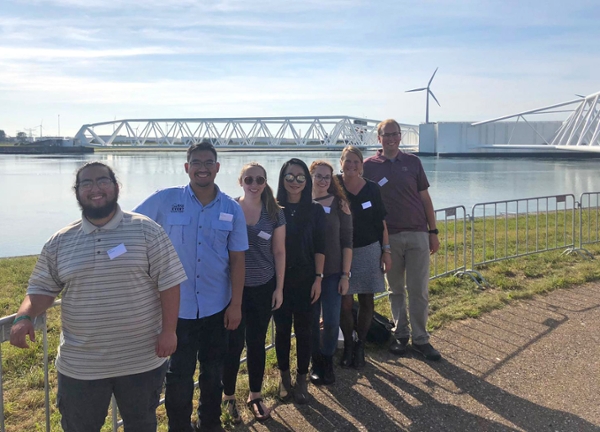Building Barriers With the Best: A&M-Galveston Visit to the Netherlands Continues to Benefit Flood Risk Mitigation Education
The structure is over 70 feet high with steel gates nearly 700 feet long and weighs in at nearly 7500 tons.
“It looks like the Eiffel Tower set on its side. They’re certainly impressive,” says Dr. William “Bill” Merrell of the Netherland’s Maeslant Barrier.
Merrell, the George P. Mitchell ’40 chair in marine sciences at Texas A&M University at Galveston and professor in the university’s Center for Texas Beaches & Shores (CTBS), has made multiple trips to the Netherlands over the past decade studying the country’s famous flood storm surge barrier in hopes of constructing one similar to it here at home in the Greater Houston-Galveston area.
Merrell’s additional mission with the visits has been to inform staff, students and stakeholders about the novel flood mitigation techniques perfected by the Dutch to bring back home to Galveston Bay.
Part of the visiting delegation on this trip included A&M-Galveston leadership, five students, a handful of concerned citizens, Morgan’s Point Mayor Michel Bechtel and Texas General Land Office Commissioner George P. Bush.
“The Dutch were very accommodating and even flew the Texas flag at the barrier, which was a nice touch. They flew it when the gates closed, too,” Merrell said with a laugh.
For Merrell, it was a fairly typical trip. He escorted the delegation to various sites featuring a barrier, flood mitigation-related structure or affected area. One exception Merrell said was that this visit included consideration of urban landscapes and protecting those from coastal flooding, whereas in the past, the focus has been on freshwater flooding. The visits are usually scheduled around the closing of the big gates at Rotterdam, which occurs once a year. Though it’s a sight Merrell has taken in many times, the gargantuan size of the structure still strikes him.
“Once you look at it, you kind of see the scale and how it’s just huge. You don’t believe it until you see it,” he explains. “You have an intellectual belief, but until you touch it and see it with your own eyes, it’s hard to imagine that they were able to actually build this.”
Merrell said the five A&M-Galveston students were treated to special academic lectures given by top Dutch flood mitigation strategists. The students are enrolled in a marine sciences class titled, “International Experiences in Flood Risk Reduction,” with the goal of understanding major factors causing floods and approaching the issue from different disciplines “such as ecological, social, economic, organizational, planning, and built-environment perspectives.”
Marine resources management student Gregory Grimm ’19 was one of the students in attendance.
Grimm said he was inspired by the trip to look into how the innovations by the Dutch could be applied in Texas for reasons both professional and personal.
“As a resident of an area that is flood-prone as well as being personally affected by flooding from Hurricane Harvey, I understand the need for a barrier to be built to prevent damage from hurricanes and storm surges in the future,” Grimm said.
Part of the visit also involved A&M-Galveston students meeting with graduate students from the Netherlands’ Delft University of Technology (TU Delft), who will be coming to A&M-Galveston for the spring 2020 semester.
Merrell said the university has now sent 60 students to the Netherlands and is excited to announce TU Delft will be sending five students in February to work on Galveston Bay coastal barrier and flood risk reduction issues. Part of this exchange is funded via the National Science Foundation’s (NSF) Partnerships for International Research and Education (PIRE) program, the particular program available to A&M-Galveston being the NSF PIRE Coastal Flood Risk Reduction Research Travel Program focusing on field research in the Netherlands.
“This has been a really nice academic exchange,” Merrell said. “We’ve talked about a joint Ph.D. program, which will hopefully happen soon. TU Delft is pretty widely recognized as the best innovative engineering and water technology-related university in the world.”
With this forthcoming Ph.D. program in particular, Merrell says his hope is that A&M-Galveston will be turning out the technical and educational leaders of the future of the field in flood risk mitigation.
“What we’re seeing is that you’re going to have much more intense rainfall events, either from tropical storms, hurricanes or just cold fronts hitting moisture-leaden atmosphere from the gulf,” he said. “Especially for the Texas and Louisiana areas, we’re looking at the new normal. Instead of a single event, I think we’ll have to prepare ourselves for this future and do better for our population and communities through our students.”

Marine resources management student Gregory Grimm ’19 poses in front of a statue near one of the natural coastal barriers in the Netherlands.

Texas A&M University at Galveston students pose in front of the Netherlands’ Maeslant Barrier during a recent flood mitigation education-related visit to the country.
Media Contact
Andréa Bolt
Communications Specialist
a_bolt@tamug.edu